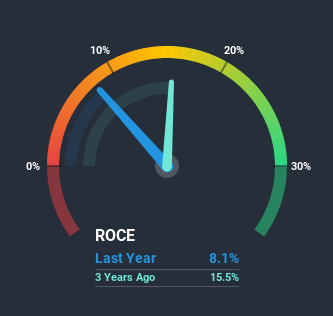- South Korea
- /
- Auto Components
- /
- KOSDAQ:A215360
Be Wary Of Woory Industrial (KOSDAQ:215360) And Its Returns On Capital
If we want to find a stock that could multiply over the long term, what are the underlying trends we should look for? Firstly, we'd want to identify a growing return on capital employed (ROCE) and then alongside that, an ever-increasing base of capital employed. Basically this means that a company has profitable initiatives that it can continue to reinvest in, which is a trait of a compounding machine. Having said that, from a first glance at Woory Industrial (KOSDAQ:215360) we aren't jumping out of our chairs at how returns are trending, but let's have a deeper look.
Understanding Return On Capital Employed (ROCE)
For those that aren't sure what ROCE is, it measures the amount of pre-tax profits a company can generate from the capital employed in its business. The formula for this calculation on Woory Industrial is:
Return on Capital Employed = Earnings Before Interest and Tax (EBIT) ÷ (Total Assets - Current Liabilities)
0.081 = ₩10b ÷ (₩249b - ₩120b) (Based on the trailing twelve months to December 2020).
So, Woory Industrial has an ROCE of 8.1%. In absolute terms, that's a low return, but it's much better than the Auto Components industry average of 5.1%.
See our latest analysis for Woory Industrial

Above you can see how the current ROCE for Woory Industrial compares to its prior returns on capital, but there's only so much you can tell from the past. If you'd like, you can check out the forecasts from the analysts covering Woory Industrial here for free.
What Can We Tell From Woory Industrial's ROCE Trend?
In terms of Woory Industrial's historical ROCE movements, the trend isn't fantastic. Around five years ago the returns on capital were 20%, but since then they've fallen to 8.1%. However it looks like Woory Industrial might be reinvesting for long term growth because while capital employed has increased, the company's sales haven't changed much in the last 12 months. It's worth keeping an eye on the company's earnings from here on to see if these investments do end up contributing to the bottom line.
On a related note, Woory Industrial has decreased its current liabilities to 48% of total assets. That could partly explain why the ROCE has dropped. What's more, this can reduce some aspects of risk to the business because now the company's suppliers or short-term creditors are funding less of its operations. Some would claim this reduces the business' efficiency at generating ROCE since it is now funding more of the operations with its own money. Keep in mind 48% is still pretty high, so those risks are still somewhat prevalent.
What We Can Learn From Woory Industrial's ROCE
To conclude, we've found that Woory Industrial is reinvesting in the business, but returns have been falling. Additionally, the stock's total return to shareholders over the last five years has been flat, which isn't too surprising. On the whole, we aren't too inspired by the underlying trends and we think there may be better chances of finding a multi-bagger elsewhere.
On a final note, we've found 1 warning sign for Woory Industrial that we think you should be aware of.
While Woory Industrial may not currently earn the highest returns, we've compiled a list of companies that currently earn more than 25% return on equity. Check out this free list here.
If you decide to trade Woory Industrial, use the lowest-cost* platform that is rated #1 Overall by Barron’s, Interactive Brokers. Trade stocks, options, futures, forex, bonds and funds on 135 markets, all from a single integrated account. Promoted
Valuation is complex, but we're here to simplify it.
Discover if Woory Industrial might be undervalued or overvalued with our detailed analysis, featuring fair value estimates, potential risks, dividends, insider trades, and its financial condition.
Access Free AnalysisThis article by Simply Wall St is general in nature. It does not constitute a recommendation to buy or sell any stock, and does not take account of your objectives, or your financial situation. We aim to bring you long-term focused analysis driven by fundamental data. Note that our analysis may not factor in the latest price-sensitive company announcements or qualitative material. Simply Wall St has no position in any stocks mentioned.
*Interactive Brokers Rated Lowest Cost Broker by StockBrokers.com Annual Online Review 2020
Have feedback on this article? Concerned about the content? Get in touch with us directly. Alternatively, email editorial-team (at) simplywallst.com.
About KOSDAQ:A215360
Woory Industrial
Manufactures and sells automotive parts and components for IC and electric engines in South Korea and internationally.
Adequate balance sheet with slight risk.
Market Insights
Community Narratives




